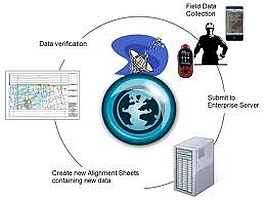2-D Trilateration
Imagine you are somewhere in the United States and you are TOTALLY lost — for whatever reason, you have absolutely no clue where you are. You find a friendly local and ask, “Where am I?” He says, “You are 625 miles from Boise, Idaho.”
This is a nice, hard fact, but it is not particularly useful by itself. You could be anywhere on a circle around Boise that has a radius of 625 miles, like this:
You ask somebody else where you are, and she says, “You are 690 miles from Minneapolis, Minnesota.” Now you’re getting somewhere. If you combine this information with the Boise information, you have two circles that intersect. You now know that you must be at one of these two intersection points, if you are 625 miles from Boise and 690 miles from Minneapolis.
If a third person tells you that you are 615 miles from Tucson, Arizona, you can eliminate one of the possibilities, because the third circle will only intersect with one of these points. You now know exactly where you are — Denver, Colorado.
This same concept works in three-dimensional space, as well, but you’re dealing with spheres instead of circles. In the next section, we’ll look at this type of trilateration.
3-D Trilateration
Fundamentally, three-dimensional trilateration isn’t much different from two-dimensional trilateration, but it’s a little trickier to visualize. Imagine the radii from the previous examples going off in all directions. So instead of a series of circles, you get a series of spheres.
If you know you are 10 miles from satellite A in the sky, you could be anywhere on the surface of a huge, imaginary sphere with a 10-mile radius. If you also know you are 15 miles from satellite B, you can overlap the first sphere with another, larger sphere. The spheres intersect in a perfect circle. If you know the distance to a third satellite, you get a third sphere, which intersects with this circle at two points.
The Earth itself can act as a fourth sphere — only one of the two possible points will actually be on the surface of the planet, so you can eliminate the one in space. Receivers generally look to four or more satellites, however, to improve accuracy and provide precise altitude information.
In order to make this simple calculation, then, the GPS receiver has to know two things:
- The location of at least three satellites above you
- The distance between you and each of those satellites
The GPS receiver figures both of these things out by analyzing high-frequency, low-power radio signals from the GPS satellites. Better units have multiple receivers, so they can pick up signals from several satellites simultaneously.
Radio waves are electromagnetic energy, which means they travel at the speed of light (about 186,000 miles per second, 300,000 km per second in a vacuum). The receiver can figure out how far the signal has traveled by timing how long it took the signal to arrive. In the next section, we’ll see how the receiver and satellite work together to make this measurement.
For more Detail: How GPS Receivers Work

